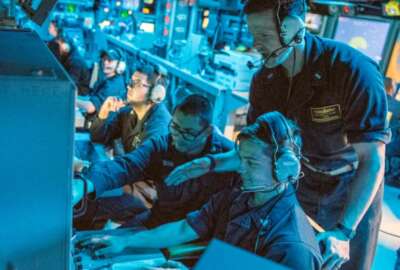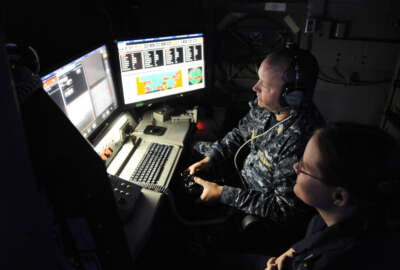
Navy updates civilian human capital policy to focus on talent, workplace quality and technology
The Navy is updating its human capital strategy for the first time in a decade.
Best listening experience is on Chrome, Firefox or Safari. Subscribe to Federal Drive’s daily audio interviews on Apple Podcasts or PodcastOne.
The Navy Department (DON) is implementing its first widespread change to how it handles its civilian workforce in nearly a decade, aimed at revolutionizing the hiring and retention and harnessing data to bring in the most talented workforce possible.
“The uniform side could not do their mission without the civilian workforce,” Navy Assistant Secretary for Manpower and Reserve Affairs Greg Slavonic told reporters during a Thursday roundtable at the Pentagon. “They make up 29% of the workforce, and that’s pretty huge.”
The new strategy takes the Navy to 2030, and revolves around five “anchors” fixated on everything from bettering the work environment to educating the workforce.
In the next three months, the Navy will set up a task force to create pilot programs based on the strategy. Over the next six months those programs, and the feedback from them, will influence how the Navy goes about creating change within its civilian force with the strategy.
“The Navy is trying to grow to 355 ships by 2030,” Slavonic said. “To be able to get to 355 ships we need to have a civilian workforce that compliments the uniform side and so we able to reach that goal. Having a well-educated and expanding workforce will help do that. We need to make sure they are where they need to be alongside our uniformed folks.”
The strategy accepts that the United States is no longer an industrial-age country, and therefore needs to adapt its work environment to that. In doing so, the Navy built the strategy keeping in mind that technology is everywhere, data is ubiquitous, artificial intelligence and robotics are part of the future, diversity is important and employees must constantly learn on the job.
The Navy strategy focuses on accessing and curating the best talent.
“The Navy must compete for talent with top-tier private and public organizations — and win the battle,” the authors of the strategy state.
To do that, the Navy will offer career mobility, access to tools and technologies and a world-class experience at work. That means upgrading the work experience for civilians.
The Navy will use AI and simplify recruiting measures to find new applicants for hard-to-fill roles.
All said, the Navy wants to increase the number of qualified applicants, and get recognized by external organizations like Forbes as great places to work. That will translate to adoption of newer technologies, reduced vacancies and a reduction in the time to fill a position.
The Navy also wants to change the way civilians are educated on the job. Slavonic said that means teaming up with the Navy’s new Chief Learning Office.
It also means identifying what skills will be needed for the future workforce and rethinking jobs.
“Rigid job criteria and other limitations prevent the organization from hiring top talent from industry or academia based on fit without a specific job that aligns with their previous work experiences,” the Navy said. “Second, role descriptions do not always adequately highlight the skills and capabilities needed given anticipated changes to work within the role.”
The Navy will redesign those criteria to reduce skill gaps and increase mobility of employees.
The Navy will strengthen its talent pipeline as well.
“Existing processes and tools do not allow DON leadership to visualize the workforce composition today nor can the DON predict how the workforce will evolve in the future,” the authors of the strategy wrote. “Talent management occurs in silos with informal, reactive processes. Given the potential retirement wave impacts on the DON, it is essential to ensure that succession planning happens proactively instead of reactively.”
The Navy will beef up its talent pipeline by identifying talent requirements and using industry best practices. It will also update its succession planning process to reduce time to fill and turnover in critical jobs.
Finally, the Navy wants to use technology to augment its workforce.
“The Navy must uncover existing efforts to augment work with smart technologies and search the marketplace for new tools that can be embedded into work,” the strategy states. “The department will pilot new technologies and scale them across the enterprise.”
It will also audit its human resources technology tools to build upon practices to improve employee experience, refresh HR technology and keep pace with technological disruption.
Copyright © 2024 Federal News Network. All rights reserved. This website is not intended for users located within the European Economic Area.
Scott Maucione is a defense reporter for Federal News Network and reports on human capital, workforce and the Defense Department at-large.
Follow @smaucioneWFED





